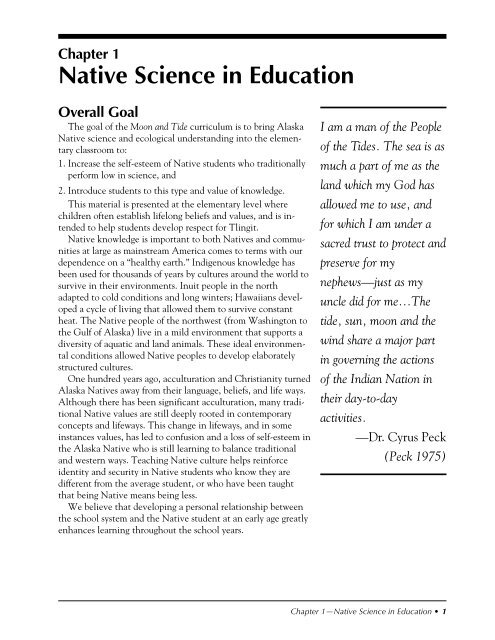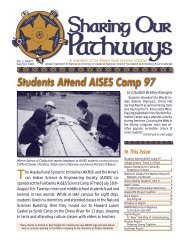Tlingit Moon & Tide - Alaska Native Knowledge Network - University ...
Tlingit Moon & Tide - Alaska Native Knowledge Network - University ...
Tlingit Moon & Tide - Alaska Native Knowledge Network - University ...
Create successful ePaper yourself
Turn your PDF publications into a flip-book with our unique Google optimized e-Paper software.
Chapter 1<br />
<strong>Native</strong> Science in Education<br />
Overall Goal<br />
The goal of the <strong>Moon</strong> and <strong>Tide</strong> curriculum is to bring <strong>Alaska</strong><br />
<strong>Native</strong> science and ecological understanding into the elementary<br />
classroom to:<br />
1. Increase the self-esteem of <strong>Native</strong> students who traditionally<br />
perform low in science, and<br />
2. Introduce students to this type and value of knowledge.<br />
This material is presented at the elementary level where<br />
children often establish lifelong beliefs and values, and is intended<br />
to help students develop respect for <strong>Tlingit</strong>.<br />
<strong>Native</strong> knowledge is important to both <strong>Native</strong>s and communities<br />
at large as mainstream America comes to terms with our<br />
dependence on a “healthy earth.” Indigenous knowledge has<br />
been used for thousands of years by cultures around the world to<br />
survive in their environments. Inuit people in the north<br />
adapted to cold conditions and long winters; Hawaiians developed<br />
a cycle of living that allowed them to survive constant<br />
heat. The <strong>Native</strong> people of the northwest (from Washington to<br />
the Gulf of <strong>Alaska</strong>) live in a mild environment that supports a<br />
diversity of aquatic and land animals. These ideal environmental<br />
conditions allowed <strong>Native</strong> peoples to develop elaborately<br />
structured cultures.<br />
One hundred years ago, acculturation and Christianity turned<br />
<strong>Alaska</strong> <strong>Native</strong>s away from their language, beliefs, and life ways.<br />
Although there has been significant acculturation, many traditional<br />
<strong>Native</strong> values are still deeply rooted in contemporary<br />
concepts and lifeways. This change in lifeways, and in some<br />
instances values, has led to confusion and a loss of self-esteem in<br />
the <strong>Alaska</strong> <strong>Native</strong> who is still learning to balance traditional<br />
and western ways. Teaching <strong>Native</strong> culture helps reinforce<br />
identity and security in <strong>Native</strong> students who know they are<br />
different from the average student, or who have been taught<br />
that being <strong>Native</strong> means being less.<br />
We believe that developing a personal relationship between<br />
the school system and the <strong>Native</strong> student at an early age greatly<br />
enhances learning throughout the school years.<br />
I am a man of the People<br />
of the <strong>Tide</strong>s. The sea is as<br />
much a part of me as the<br />
land which my God has<br />
allowed me to use, and<br />
for which I am under a<br />
sacred trust to protect and<br />
preserve for my<br />
nephews—just as my<br />
uncle did for me…The<br />
tide, sun, moon and the<br />
wind share a major part<br />
in governing the actions<br />
of the Indian Nation in<br />
their day-to-day<br />
activities.<br />
—Dr. Cyrus Peck<br />
(Peck 1975)<br />
Chapter 1—<strong>Native</strong> Science in Education • 1



